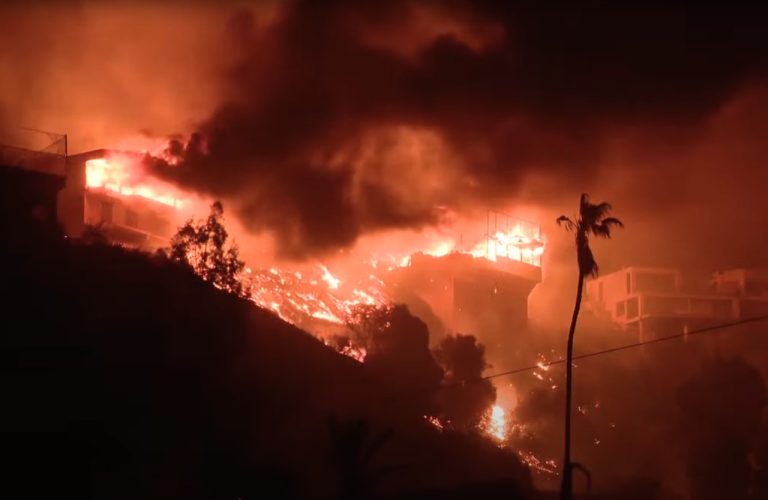
Los Angeles' devastating wildfires have once again become a rallying cry for those who blame climate change for natural disasters. [emphasis, links added]
Recent reports, such as those from Axios and the BBC, hastily and incorrectly linked these wildfires to a “rare confluence of climate factors,” a narrative that has become all too familiar.
However, any such connection is not supported by data.
Too often, linking individual wildfires or even a year's worth of wildfires to long-term climate change oversimplifies complex natural events and fails to address the broader context.
To truly understand these fires, we must consider history, meteorology and land management, not just the latest climate narrative.
California has a long history of wildfires, the vast majority of which occurred before human-induced climate change became a focus of discussion. Historical records and research show that the region has always been prone to fire cycles.
For example, a study published by the U.S. Forest Service highlighted Wildfires play an important role in California's natural ecology, with fire recurrence intervals ranging from decades to centuries, depending on the ecosystem.
Native Americans set fires to manage vegetation and prevent catastrophic wildfires. However, these practices were abandoned after European settlement, leading to the accumulation of fuel in the forests.
Today's fires, while tragic, are consistent with the region's long history of natural and human-influenced fire activity.
What's the reason? Santa Ana winds, that's weather, not climate.
Los Angeles’ current fires are largely caused by the infamous Santa Ana winds, a well-documented weather phenomenon. These dry gusts blow from inland deserts to the coast, creating perfect conditions for fires to spread quickly.
The National Weather Service provides a detailed explanation of Santa Ana winds, describing how they are driven by a high-pressure system over the Great Basin. All it takes is a spark or an arsonist. sparking a violent, wind-driven wildfire.
In the satellite video below cooperative institute Atmosphere, note how Santa Ana winds from the northeast fan the fire and blow the smoke quickly out to sea.
this Axios The article described the fires as being fueled by “climate factors,” but Santa Ana's winds did not change as the planet warmed, a textbook example of weather, not climate.
Weather describes short-term atmospheric conditions, while climate refers to long-term trends over decades or centuries. To conflate the two is to distort science.
Another key factor in California’s wildfire problem is land management. Decades of fire suppression policies have allowed fuels (also known as dead trees, dry brush and dense vegetation) to accumulate, creating flammable conditions.
A report from Cal Fire explains the role of vegetation management in reducing fire risk and outlines how fuel accumulation can make fires more severe.
Why does every natural disaster now seem to have a climate change label?
At the same time, urban expansion into wildland areas (the so-called wildland-urban interface) puts more homes and infrastructure at risk. Research from the University of California, Berkeley, highlights the challenges posed by housing development in fire-prone areas.
Historically, fires that would have caused the natural thinning of forests and clearing of underbrush were suppressed, resulting in denser forests and more intense burning.
These issues receive far less attention than the simple assertion that “climate change” is to blame.
Why does every natural disaster now seem to have a climate change label?
The media and policymakers are increasingly linking bizarre weather events—hurricanes, droughts, floods, and now wildfires—to global warming, also known as climate change.
While climate does affect weather patterns, blaming every fire or flood on climate change often ignores critical context.
The Axios article mentioned “rare climatic factors” but did not provide specific details. Are these factors quantifiable or speculative? Without strict data, These claims are more like hyperbole talking points than scientific evidence.
Blaming climate change for wildfires may make for a simplistic headline, but it distracts from real solutions. Improving forest management, enforcing sound building codes, and investing in early detection and firefighting infrastructure can significantly reduce the risk and impact of wildfires.
The Little Hoover Commission is an independent state watchdog that has been outspoken about the need for better forest management practices in California ( source ).
For example, clearing and halting the demolition of forest roads so that firefighters can more easily extinguish fires in remote wilderness areas before they spread to more populated areas would be a good policy response to reduce deaths from fires. resulting loss of land, buildings and lives.
Another approach is to reintroduce large-scale logging in overcrowded forest areas to reduce the fuel available in the event of fires.
Policies driven by the climate change narrative often prioritize symbolic action over practical measures. For example, California's focus on renewable energy mandates and electric vehicles (EVs) has little or no impact on the short- or long-term risk of wildfires.
Worse, these policies may divert resources from critical fire protection measures.
California’s wildfires are tragic, but not unprecedented. The media's rush to attribute these fires to climate change reflects a broader trend of politicizing natural disasters, often at the expense of meaningful solutions.
It is critical to approach wildfire issues with a clear understanding of history, science, and policy.
The fires in Los Angeles are a reminder not of climate catastrophe, but of the importance of thoughtful land management and disaster preparedness—with solutions grounded in reality, not rhetoric.
Top image from YouTube screencap
Read more Climate Realism
